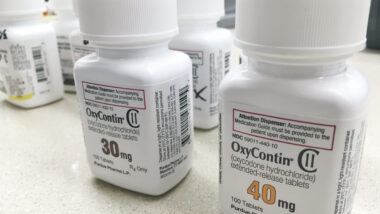Top Class Actions’s website and social media posts use affiliate links. If you make a purchase using such links, we may receive a commission, but it will not result in any additional charges to you. Please review our Affiliate Link Disclosure for more information.
Peripheral T-cell lymphoma is a subtype of non-Hodgkin’s lymphoma that itself has many subtypes. This cancer is associated with abnormal growth of cells key to the performance of the immune system and is a particularly aggressive type of cancer and has been linked to Roundup weedkiller.
One factor that scientific studies have shown may lead to a greater risk of developing non-Hodgkin’s lymphomas like peripheral T-cell lymphoma is exposure to a chemical called glyphosate.
Glyphosate is the most popular weedkiller in the world. Approximately 300 million pounds of the chemical are applied to crops around the globe each year. Since the weedkiller was discovered, more than nine billion tons of the chemical have been used on crops and gardens worldwide. The weedkiller may be used by commercial farmers, groundskeepers, parks workers, home gardeners, landscapers, and many others. However, exposure to the chemical may result in serious health consequences such as peripheral T-cell lymphoma, especially if the exposure is prolonged or takes place over many years.
Glyphosate is the primary ingredient of Roundup weedkiller. Roundup is manufactured by Monsanto, now owned by Bayer. Business Insider reports that Monsanto has faced more than 13,000 lawsuits regarding claims that their weedkiller caused the plaintiff’s cancer.
Peripheral T-Cell Lymphoma Overview
According to the Lymphoma Research Foundation, peripheral T-cell lymphomas are a group of aggressive lymphomas under the category of non-Hodgkin’s lymphoma. These cancers involve abnormal cell growth. Non-Hodgkin’s lymphomas affect two different types of white blood cells, B-cells and T-cells. Peripheral T-cell lymphoma specifically involves T-cell growth and originates in the lymphatic system.
The term ‘peripheral,” in this case, refers to the fact that peripheral T-cell lymphoma arises in lymphatic tissue that is located outside of the bone marrow. These locations include the lymph nodes, gastrointestinal tract, spleen, and skin. Most types of peripheral T-cell lymphoma are aggressive and fast-growing.
What Are Peripheral T-Cell Lymphoma Symptoms?
The cells associated with peripheral T-cell lymphoma are a key component of the body’s immune response. There are many subtypes of peripheral T-cell lymphoma, but all of them have this trait in common, and they often present in similar ways.
This cancer is associated with widespread lymph node enlargement without pain in the armpit, neck, or groin. A person with peripheral T-cell lymphoma might also experience night sweats, weight loss, fever, skin rash, and enlargement of the liver and spleen.
Peripheral T-Cell Lymphoma Diagnosis
According to the Leukemia & Lymphoma Society (LLS), in most cases, doctors diagnose peripheral T-cell lymphoma by doing a biopsy. A biopsy is a small sample of tissue, lymph tissue in this case, and that tissue sample is then tested by a hematopathologist, a doctor specializing in diagnosing diseases of the blood and marrow. Generally, to do this test, either the lymph node or a part of the lymph node must be surgically removed. This can often be done with the use of local anesthetic.
Due to the similarities in the behavior of the cells in many subtypes of peripheral T-cell lymphoma, a biopsy may not be enough on its own for a diagnosis. Further diagnostic tests like blood tests may be needed for more accuracy. Other tests that your doctor may order to help them diagnose your condition may include magnetic resonance imaging (MRI) scans, positron emission tomography (PET) scans, computerized axial tomography (CT) scans, and a bone marrow biopsy.

What Is the Peripheral T-Cell Lymphoma Survival Rate?
The survival rate of peripheral T-cell lymphoma is determined by a prognostic index. There have been a number of different prognostic indexes for peripheral T-cell lymphoma in the past, but studies have shown that the Prognostic Index for Peripheral T-Cell Lymphoma (PIT) is the most reliable.
The PIT separates patients into prognostic groups depending on what risk factors they may have. The PIT risk factors are age greater than 60, bone marrow involvement, performance status, and serum lactate dehydrogenase (LDH).
Based on the PIT, those with peripheral T-cell lymphomas with no risk factors have a 62% overall survival (OS) rate after five years, and 55% after 10 years. Those with one risk factor have a five-year OS rate of 53%, and 39% after 10 years. With two risk factors, patients have a five-year OS rate of 33%, and 18% after 10 years. For patients with three to four risk factors, the 5-year OS is 18%, and the 10-year OS is 12%.
Peripheral T-cell lymphoma treatment is more effective the earlier it begins, so diagnosing and treating this condition should happen as soon as possible. If you’re experiencing any of the symptoms described above, be sure to speak with a doctor.
How Is Peripheral T-Cell Lymphoma Linked to Roundup?
Over the years, Bayer has faced thousands of lawsuits regarding cancer allegedly caused by their weedkiller, Roundup. Business Insider reports that glyphosate, the main component of Roundup, has been categorized as a probable carcinogen by the World Health Organization and is on California’s Environmental Protection Agency’s Office of Environmental Health Hazard Assessment’s list of known carcinogens.
Meta-analysis of studies done on the effects of glyphosate on the human body has shown a link between glyphosate exposure and increased risk of non-Hodgkin’s lymphomas, an umbrella term under which peripheral T-cell lymphoma falls. The meta-analysis found further support of a connection between glyphosate exposure and endocrine disruption, immunosuppression, and other genetic alterations commonly associated with non-Hodgkin’s lymphomas.
The study found that those exposed to the main ingredient of Roundup were 41% more likely to develop cancer than those who weren’t.
Glyphosate exposure may occur when people using the weedkiller do not take proper precautions to avoid swallowing, inhaling, or touching the chemical. Glyphosate spray may be inhaled or swallowed while it is being sprayed on plants and weeds. The chemical may also be absorbed through the skin if plants that have recently been sprayed are touched before the spray has dried. In addition to the dangers posed to people who come into contact with glyphosate, the chemical may also be hazardous to pets and other animals.
In some cases, glyphosate exposure may occur even when people have not come into direct contact with the weedkiller. As glyphosate is often used to dessicate and dry out crops immediately before they are harvested, the chemical may wind up in household products such as cereal.
Peripheral T-cell lymphoma is also related to Roundup through the sheer number of cancer lawsuits facing the weedkiller’s manufacturers. These lawsuits have proven to be incredibly expensive for Bayer. In fact, the St. Louis Business Journal reported that on June 24, 2020, Bayer announced they would be settling a large portion of the litigation against them for between $10.1 billion and $10.9 billion.
Although some Roundup lawsuit settlements have later been reduced, many plaintiffs have been awarded millions of dollars for their injuries, medical expenses, and pain and suffering. Unfortunately, as the cancers believed to be caused by glyphosate exposure may take years or decades to develop, it is often too late to treat the condition by the time it is diagnosed.
If you or a loved one has developed peripheral T-cell lymphoma after long-term use or exposure to Roundup weed killer or glyphosate, you may be eligible to join a class action suit against the manufacturer.
Join a Roundup Weed Killer Cancer Class Action Lawsuit Investigation
You may qualify for this Roundup cancer lawsuit investigation if you were diagnosed with one of these conditions after using Roundup:
- Non-Hodgkin’s lymphoma
- B-cell lymphoma
- T-cell lymphoma
- Chronic lymphocytic leukemia (CLL)
- Hairy cell lymphoma
See if you qualify by filling out the form on this page for a case evaluation with an experienced Roundup lawsuit attorney.
This article is not legal advice. It is presented
for informational purposes only.
ATTORNEY ADVERTISING
Top Class Actions is a Proud Member of the American Bar Association
LEGAL INFORMATION IS NOT LEGAL ADVICE
Top Class Actions Legal Statement
©2008 – 2024 Top Class Actions® LLC
Various Trademarks held by their respective owners
This website is not intended for viewing or usage by European Union citizens.
Get Help – It’s Free
Join a Roundup Weed Killer Cancer Class Action Lawsuit Investigation
For the most up-to-date information on this case, click here.













